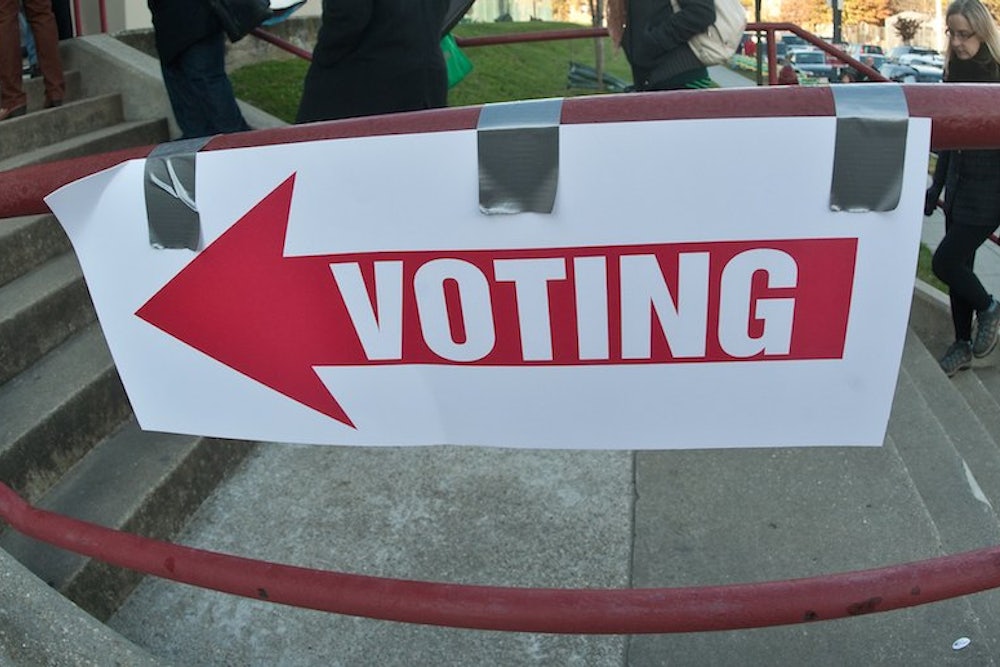The Democrats’ midterm drop off problem is as well understood as it is intractable. For a number of reasons, young adults and minorities are less likely to vote in midterm elections than in general elections, and since young people and minorities vote disproportionately for Democrats, while old people vote disproportionately for Republicans, Democrats perform significantly worse in midterms than in general elections.
To stem or reverse that problem, Democrats need to identify the drop off voters and figure out how to get them to show up at the polls every two years as opposed to every four. As Sasha Issenberg recently wrote in the pages of this magazine, “the midterm imperative is clear: Raise the dollars and secure the volunteer commitments. Then go and turn out those who are already on your side but won’t show up without a friendly nudge.”
But it’s not quite as straightforward as making unreliable voters more reliable. For every unit of energy and resources Democrats devote to reduce the difference between their midterm and general electorates, Republicans are responding—not with turnout-boosting strategies of their own, but by making it harder for the pool of voters who make up that difference to vote, even if they want to. In a way, the story of the 2014 elections can be boiled down to two counterposed strategies, with Democrats on one side trying to mitigate their midterm drop off and Republicans on the other trying to exacerbate it. In 2012, Republican efforts to suppress Democratic turnout may have backfired. The Republican response was not to scale back those efforts but to make them more impervious to blowback.
No two stories heighten the contrast between strategies than this Washington Post article about Senator Mark Begich’s unrivaled ground game in Alaska—the most difficult state in the country to canvas—and this News & Observer article about the conservative advocacy group Americans for Prosperity, which ran afoul of the North Carolina election board by sending hundreds of thousands of erroneous voter registration forms to residents (and at least one cat) around the state.
The plan in Alaska is logistically complex, due to Alaska’s unforgiving geography, but it’s also remarkably simple: find Democrats who have a hard time voting and help them vote. In Alaska, that means sending volunteers to tiny, far off villages. But in other battlegrounds, it means finding students, minorities, and other itinerate constituencies, who only vote in presidential election years, or whose voter registrations have lapsed, and getting them to cast ballots.
The Democratic Senatorial Campaign Committee dubs this plan the Bannock Street Project. It’s a $60 million effort, underway in states like North Carolina and Michigan, where Democrats are winning, but also in states like Alaska, Arkansas, Georgia, and Iowa, where polls show Democrats a few points behind. The idea is there is to make sure Democrats outperform their polls, and hold on to seats they currently control.
I don’t know if the plan will work. But it notably and admirably deploys cutting edge electoral science to the end of making more, rather than fewer, people vote. The Republican counterstrategy is almost exactly the opposite.
It’s unclear whether AFP or other conservative groups are sending misleading application forms to voters in states other than North Carolina (though AFP has a storied history of intimidating and caging voters with shady mailers in recent years). But in North Carolina, and maybe elsewhere, these efforts work in tandem with new, highly restrictive laws, which are nominally intended to reduce non-existent problems like voter fraud and election spending, but are in fact designed to make it harder for young people and minorities to vote, even if they intend to.
After the Supreme Court gutted the Voting Rights Act last year, North Carolina passed the most restrictive voting law in the country. It included a much-discussed voter ID requirement, but, perhaps more importantly, it canceled a week of early voting, did away with a pre-registration program for high school students, nixed same-day registration, and eliminated provisional ballots for voters who show up at the wrong precinct.
Last week, an appeals court enjoined the latter two measures. North Carolina will appeal that ruling to the Supreme Court, and next year, advocates will challenge the entire law in federal court. But if the Supreme Court reverses the injunction, the whole thing will be in effect this November. Which means Bannock Street and other get-out-the-vote efforts will face formidable challenges—and people who get taken in by shady mailers or other dirty tricks will have little recourse.
Voting rights advocates are also asking courts to weigh in against suppressive voter ID laws in other battlegrounds—including Wisconsin, where Democrats are hoping to unseat Governor Scott Walker; and Arkansas, which may determine whether Democrats maintain control of the U.S. Senate. Tens of thousands of registered voters in these states don’t have, and will be unable to secure, proper identification in time for the election. Since Democrats respond to voter suppression efforts with more sophisticated organizing and GOTV, the idea this year is to make those suppression tactics less vulnerable to those efforts.
So the question isn’t just whether Democrats can find their drop-off supporters and turn them out to the polls, but, assuming that plan is successful, whether Republicans will let them vote when they get there.

